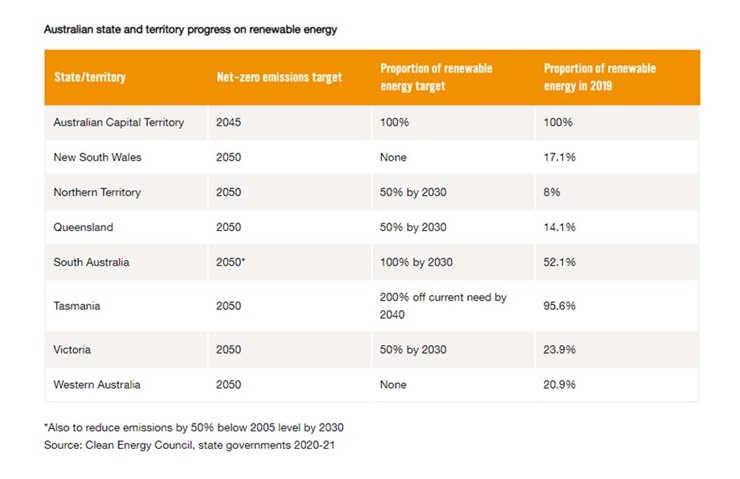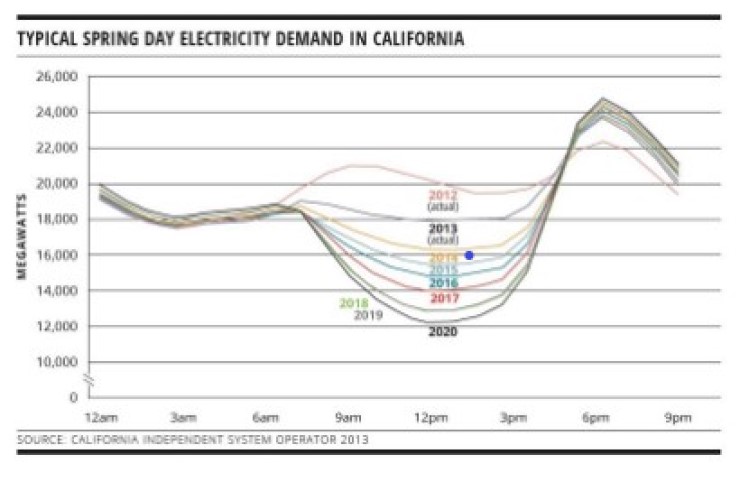KangaNews - The big renewal
Westpac Institutional Bank is taking a lead position in Australia’s renewable-energy space – a key sector for investment growth.

By KangaNews
Perhaps contrary to some perceptions, renewable-energy facilities are not new in Australia. Solar started playing a role in the national power grid 10-15 years ago, wind facilities have existed for more than two decades and before these the country derived a small portion of its grid power from hydro generation.
Renewables contributed around 15 per cent of Australia’s total electricity generation by the end of 2018 according to International Renewable Energy Agency data. This is comparable with the US but significantly lower than other developed nations: the equivalent figure for Germany was 46 per cent, for the UK 33 per cent and for New Zealand 84 per cent.
Australia’s renewable-energy contribution had climbed to around 20 per cent of the total by the end of 2020 according to Westpac. But there is clearly still significant potential in the transition process – and the time to do it is fast approaching if it has not already arrived.
The vast majority – around 90 per cent – of coal-fired generation capacity in New South Wales (NSW) will reach the end of its functional lifespan by the mid-2030s. The increasing cost-effectiveness of renewable-energy sources, growing global concern about the impact of climate change and stranded-asset risk in the fossil-fuel space suggest the most rational course of action will be to replace the expiring capacity with renewable energy.
States and territories are mainly well progressed with the transition to renewables – perhaps most notably the Australian Capital Territory and South Australia. Most have made flightpath commitments to either or both of a proportion of power from renewables or net-zero carbon emissions (see table).

It is the states that will drive investment in renewable energy. The scale of the task is vast even at current commitment levels. Myles Walkington, relationship manager, infrastructure and utilities at Westpac in Melbourne, points to NSW’s now-legislated energy roadmap as an example.
“Part of this is what is called ‘renewable-energy zones’ – effectively the placement of a lot of renewable-energy generation in areas where it makes sense and ensuring the appropriate network connections are in place to deliver the energy to where it needs to go. The state government’s expectation is that these renewable-energy zones could attract more than A$30 billion [US$23.2 billion] of private investment over the next 10-15 years,” Walkington says.
Wider opportunity
Nor is electricity transition merely a story of like-for-like generation replacement. There is no shortage of investment opportunities in the generation space and Westpac has supported more than its share of these (see box).
But two further system-wide issues are also at play: the fact that a predominantly renewables-based electricity grid works in a fundamentally different way from a fossil-fuel-powered one, and the likelihood that aggregate demand for grid power will grow substantially as part of an economy-wide low-carbon transition.
“One aspect of the transition is the shift from very large power stations with heavy load interconnect shipping into a central grid, to more distributed energy with smaller power stations that tend to be further away,” says David Scrivener, global head of energy, infrastructure and resources at Westpac in Melbourne.
He explains that this aspect of planning for the power network forms another piece of the NSW energy roadmap – not just designating and developing renewable-energy zones but also adding suitable connections to them so they can reliably transmit energy when and where needed. This marks notable progress, Scrivener adds, from a historical focus on building projects while neglecting the fact that they might be at the end of skinny, low-capacity transmission lines.
Of perhaps even more significance is the way demand patterns will shift as the source of power generation changes. In particular, increased take-up of household solar generation is likely to produce the “duck curve” – a pattern of electricity supply and demand that increasingly flexes around daylight hours (see chart). As household solar generation increases during the day, demand for electricity from the grid drops. As the sun sets and people return home in the evening, network demand rises to a peak.

Household battery storage is still a nascent technology, although some energy retailers are exploring how they can work with households to install batteries to help manage supply and demand. Meanwhile, major projects like Hydro Tasmania’s “battery of the nation” – a 4.5-5GW battery that will be used to balance the grid as it moves from coal-fired power to more intermittent styles of generation – are already demanding investment capital.
Either way, the capex component will be substantial. “We are still working through questions around how to plan a network under these conditions. Who operates and has control of it will also become an interesting issue,” Scrivener says.
The importance of answering these questions will only be heightened by the wider process of electrification. Take-up of electric vehicles is still minimal in Australia but 2019 government analysis predicted that half of new vehicle sales will be electric by 2035 even at the current rate of market growth. The transition away from petrol-powered cars will naturally mean more demand on the electricity grid.
The extent of this additional demand may be impossible to estimate accurately as Scrivener suggests a wholesale transmission to electric vehicles brings several variables into play.
“The question to answer is when users plug in,” he suggests. “If they all do so at the same time, peak energy demand will go through the roof. On the other hand, if everyone times charging their cars when wind power is abundant – for example in the very early morning when there is also typically lower demand on the network – there might not be the need for as great an increase in capacity.”
The same applies, Scrivener continues, if there is a continued buildout of solar power in the sunnier states and improved interconnection between the states to distribute this power. A figure of A$80 billion might not be an unreasonable estimate of the scale of investment needed to power a full-scale transition to electric vehicles, he argues.
“The grid was designed a century ago and needs to be made fit for purpose,” Scrivener concludes. “The good news is that all the regulated transmission distribution companies are alive to this change. But it is inevitable that we will need a significant amount of capital to deal with the transition.”
Funding methods
The pipeline of this capex to the debt capital market is likely to be protracted but should in time produce new credit issuance – potentially in labelled-debt format. The slow transmission is a result of the age-old disconnect between bond financing and greenfield infrastructure development.
“Debt capital market issuance has not to date been looked at for renewable-energy projects that are done via traditional project financing,” Walkington acknowledges. “This primarily reflects the fact that they tend to be in the sub-to-just investment-grade credit profile.”
The Australian policy landscape remains relatively infertile soil for the type of revenue certainty bond markets tend to crave. Scrivener explains, for instance, that some German renewable-energy project finance has achieved bond-market funding because generators were given a guaranteed tariff by the government for the life of the project. Australian renewable-energy assets still offer attractive investment opportunities but they tend to carry merchant-power risk – which makes investment-grade bond issuance challenging.
Even so – and setting aside the theoretical potential for more esoteric funding mechanisms like multiple-project securitisation – the scale and breadth of the transition task in Australia is likely to provide debt-capital-market opportunities.
“The more likely piece is in electricity transmission, investment in which will drive additional capital-market issuance,” says Scrivener. “Typically, a regulated-utility company is one piece of an entity that also builds bespoke transmission lines for renewable-energy projects on an unregulated basis. These entities can secure 25-year contracts and we have seen some capital-market issuance off the back of them, including long-dated, 25-year paper being written.”
It is also possible that renewable-energy projects with mainstream, established sponsors from the electricity and resources sectors could be used as eligible assets for use-of-proceeds green bonds. There may be something of a Goldilocks factor here, however. Scrivener points out that while standalone projects may not offer a bond-market-suitable credit profile, the other side of the same coin is that major global energy companies – the likes of BP, Shell and Total – tend to be cash-rich and thus not in great need of capital-market funding for specific projects.
The middle road is likely to be local power and utility companies, and banks themselves. Near-term conditions have all but removed Australia’s major banks from wholesale funding markets, but they are likely to be keen to explore further green-bond issuance as and when they return. Electricity transition could be a crucial source of suitable assets.
“Green lending will inevitably drive more green-bond issuance. From a Westpac perspective, lending to renewable-energy projects can be wrapped up in our green-bond programme – which should enable Westpac to issue more green bonds. The decision ultimately is with group treasury but certainly the billions of dollars of capex will create more capacity for our green programme,” Scrivener suggests.
This article originally appeared in the Kanga News – Investing with Impact Yearbook March 2021
Stay informed with Westpac IQ
Get the latest reports straight to your inbox.
Browse topics
Disclaimer
©2025 Westpac Banking Corporation ABN 33 007 457 141 (including where acting under any of its Westpac, St George, Bank of Melbourne or BankSA brands, collectively, “Westpac”). References to the “Westpac Group” are to Westpac and its subsidiaries and includes the directors, employees and representatives of Westpac and its subsidiaries.
Things you should know
We respect your privacy: You can view the New Zealand Privacy Policy here, or the Australian Group Privacy Statement here. Each time someone visits our site, data is captured so that we can accurately evaluate the quality of our content and make improvements for you. We may at times use technology to capture data about you to help us to better understand you and your needs, including potentially for the purposes of assessing your individual reading habits and interests to allow us to provide suggestions regarding other reading material which may be suitable for you.
This information, unless specifically indicated otherwise, is under copyright of the Westpac Group. None of the material, nor its contents, nor any copy of it, may be altered in any way, transmitted to, copied of distributed to any other party without the prior written permission of the Westpac Group.
Disclaimer
This information has been prepared by Westpac and is intended for information purposes only. It is not intended to reflect any recommendation or financial advice and investment decisions should not be based on it. This information does not constitute an offer, a solicitation of an offer, or an inducement to subscribe for, purchase or sell any financial instrument or to enter into a legally binding contract. To the extent that this information contains any general advice, it has been prepared without taking into account your objectives, financial situation or needs and before acting on it you should consider the appropriateness of the advice. Certain types of transactions, including those involving futures, options and high yield securities give rise to substantial risk and are not suitable for all investors. We recommend that you seek your own independent legal or financial advice before proceeding with any investment decision.
This information may contain material provided by third parties. While such material is published with the necessary permission none of Westpac or its related entities accepts any responsibility for the accuracy or completeness of any such material. Although we have made every effort to ensure this information is free from error, none of Westpac or its related entities warrants the accuracy, adequacy or completeness of this information, or otherwise endorses it in any way. Except where contrary to law, Westpac Group intend by this notice to exclude liability for this information. This information is subject to change without notice and none of Westpac or its related entities is under any obligation to update this information or correct any inaccuracy which may become apparent at a later date. This information may contain or incorporate by reference forward-looking statements. The words “believe”, “anticipate”, “expect”, “intend”, “plan”, “predict”, “continue”, “assume”, “positioned”, “may”, “will”, “should”, “shall”, “risk” and other similar expressions that are predictions of or indicate future events and future trends identify forward-looking statements. These forward-looking statements include all matters that are not historical facts. Past performance is not a reliable indicator of future performance, nor are forecasts of future performance. Whilst every effort has been taken to ensure that the assumptions on which any forecasts are based are reasonable, the forecasts may be affected by incorrect assumptions or by known or unknown risks and uncertainties. The ultimate outcomes may differ substantially from any forecasts.
Conflicts of Interest: In the normal course of offering banking products and services to its clients, the Westpac Group may act in several capacities (including issuer, market maker, underwriter, distributor, swap counterparty and calculation agent) simultaneously with respect to a financial instrument, giving rise to potential conflicts of interest which may impact the performance of a financial instrument. The Westpac Group may at any time transact or hold a position (including hedging and trading positions) for its own account or the account of a client in any financial instrument which may impact the performance of that financial instrument.
Author(s) disclaimer and declaration: The author(s) confirms that (a) no part of his/her compensation was, is, or will be, directly or indirectly, related to any views or (if applicable) recommendations expressed in this material; (b) this material accurately reflects his/her personal views about the financial products, companies or issuers (if applicable) and is based on sources reasonably believed to be reliable and accurate; (c) to the best of the author’s knowledge, they are not in receipt of inside information and this material does not contain inside information; and (d) no other part of the Westpac Group has made any attempt to influence this material.
Further important information regarding sustainability-related content: This material may contain statements relating to environmental, social and governance (ESG) topics. These are subject to known and unknown risks, and there are significant uncertainties, limitations, risks and assumptions in the metrics, modelling, data, scenarios, reporting and analysis on which the statements rely. In particular, these areas are rapidly evolving and maturing, and there are variations in approaches and common standards and practice, as well as uncertainty around future related policy and legislation. Some material may include information derived from publicly available sources that have not been independently verified. No representation or warranty is made as to the accuracy, completeness or reliability of the information. There is a risk that the analysis, estimates, judgements, assumptions, views, models, scenarios or projections used may turn out to be incorrect. These risks may cause actual outcomes to differ materially from those expressed or implied. The ESG-related statements in this material do not constitute advice, nor are they guarantees or predictions of future performance, and Westpac gives no representation, warranty or assurance (including as to the quality, accuracy or completeness of the statements). You should seek your own independent advice.
Additional country disclosures:
Australia: Westpac holds an Australian Financial Services Licence (No. 233714). You can access Westpac’s Financial Services Guide here or request a copy from your Westpac point of contact. To the extent that this information contains any general advice, it has been prepared without taking into account your objectives, financial situation or needs and before acting on it you should consider the appropriateness of the advice.
New Zealand: In New Zealand, Westpac Institutional Bank refers to the brand under which products and services are provided by either Westpac (NZ division) or Westpac New Zealand Limited (company number 1763882), the New Zealand incorporated subsidiary of Westpac ("WNZL"). Any product or service made available by WNZL does not represent an offer from Westpac or any of its subsidiaries (other than WNZL). Neither Westpac nor its other subsidiaries guarantee or otherwise support the performance of WNZL in respect of any such product. WNZL is not an authorised deposit-taking institution for the purposes of Australian prudential standards. The current disclosure statements for the New Zealand branch of Westpac and WNZL can be obtained at the internet address www.westpac.co.nz.
Singapore: This material has been prepared and issued for distribution in Singapore to institutional investors, accredited investors and expert investors (as defined in the applicable Singapore laws and regulations) only. Recipients of this material in Singapore should contact Westpac Singapore Branch in respect of any matters arising from, or in connection with, this material. Westpac Singapore Branch holds a wholesale banking licence and is subject to supervision by the Monetary Authority of Singapore.
Fiji: Unless otherwise specified, the products and services for Westpac Fiji are available from www.westpac.com.fj © Westpac Banking Corporation ABN 33 007 457 141. This information does not take your personal circumstances into account and before acting on it you should consider the appropriateness of the information for your financial situation. Westpac Banking Corporation ABN 33 007 457 141 is incorporated in NSW Australia and registered as a branch in Fiji. The liability of its members is limited.
Papua New Guinea: Unless otherwise specified, the products and services for Westpac PNG are available from www.westpac.com.pg © Westpac Banking Corporation ABN 33 007 457 141. This information does not take your personal circumstances into account and before acting on it you should consider the appropriateness of the information for your financial situation. Westpac Banking Corporation ABN 33 007 457 141 is incorporated in NSW Australia. Westpac is represented in Papua New Guinea by Westpac Bank - PNG - Limited. The liability of its members is limited.
U.S.: Westpac operates in the United States of America as a federally licensed branch, regulated by the Office of the Comptroller of the Currency. Westpac is also registered with the US Commodity Futures Trading Commission (“CFTC”) as a Swap Dealer, but is neither registered as, or affiliated with, a Futures Commission Merchant registered with the US CFTC. The services and products referenced above are not insured by the Federal Deposit Insurance Corporation (“FDIC”). Westpac Capital Markets, LLC (‘WCM’), a wholly-owned subsidiary of Westpac, is a broker-dealer registered under the U.S. Securities Exchange Act of 1934 (‘the Exchange Act’) and member of the Financial Industry Regulatory Authority (‘FINRA’). In accordance with APRA's Prudential Standard 222 'Association with Related Entities', Westpac does not stand behind WCM other than as provided for in certain legal agreements between Westpac and WCM and obligations of WCM do not represent liabilities of Westpac.
This communication is provided for distribution to U.S. institutional investors in reliance on the exemption from registration provided by Rule 15a-6 under the Exchange Act and is not subject to all of the independence and disclosure standards applicable to debt research reports prepared for retail investors in the United States. WCM is the U.S. distributor of this communication and accepts responsibility for the contents of this communication. Transactions by U.S. customers of any securities referenced herein should be effected through WCM. All disclaimers set out with respect to Westpac apply equally to WCM. If you would like to speak to someone regarding any security mentioned herein, please contact WCM on +1 212 389 1269. Investing in any non-U.S. securities or related financial instruments mentioned in this communication may present certain risks. The securities of non-U.S. issuers may not be registered with, or be subject to the regulations of, the SEC in the United States. Information on such non-U.S. securities or related financial instruments may be limited. Non-U.S. companies may not be subject to audit and reporting standards and regulatory requirements comparable to those in effect in the United States. The value of any investment or income from any securities or related derivative instruments denominated in a currency other than U.S. dollars is subject to exchange rate fluctuations that may have a positive or adverse effect on the value of or income from such securities or related derivative instruments.
The author of this communication is employed by Westpac and is not registered or qualified as a research analyst, representative, or associated person of WCM or any other U.S. broker-dealer under the rules of FINRA, any other U.S. self-regulatory organisation, or the laws, rules or regulations of any State. Unless otherwise specifically stated, the views expressed herein are solely those of the author and may differ from the information, views or analysis expressed by Westpac and/or its affiliates.
UK: The London branch of Westpac is authorised in the United Kingdom by the Prudential Regulation Authority (PRA) and is subject to regulation by the Financial Conduct Authority (FCA) and limited regulation by the PRA (Financial Services Register number: 124586). The London branch of Westpac is registered at Companies House as a branch established in the United Kingdom (Branch No. BR000106). Details about the extent of the regulation of Westpac’s London branch by the PRA are available from us on request.
This communication is not being made to or distributed to, and must not be passed on to, the general public in the United Kingdom. Rather, this communication is being made only to and is directed at (a) those persons falling within the definition of Investment Professionals (set out in Article 19(5) of the Financial Services and Markets Act 2000 (Financial Promotion) Order 2005 (the “Order”)); (b) those persons falling within the definition of high net worth companies, unincorporated associations etc. (set out in Article 49(2)of the Order; (c) other persons to whom it may lawfully be communicated in accordance with the Order or (d) any persons to whom it may otherwise lawfully be made (all such persons together being referred to as “relevant persons”). Any person who is not a relevant person should not act or rely on this communication or any of its contents. In the same way, the information contained in this communication is intended for “eligible counterparties” and “professional clients” as defined by the rules of the Financial Conduct Authority and is not intended for “retail clients”. Westpac expressly prohibits you from passing on the information in this communication to any third party.
European Economic Area (“EEA”): This material may be distributed to you by either: (i) Westpac directly, or (ii) Westpac Europe GmbH (“WEG”) under a sub-licensing arrangement. WEG has not edited or otherwise modified the content of this material. WEG is authorised in Germany by the Federal Financial Supervision Authority (‘BaFin’) and subject to its regulation. WEG’s supervisory authorities are BaFin and the German Federal Bank (‘Deutsche Bundesbank’). WEG is registered with the commercial register (‘Handelsregister’) of the local court of Frankfurt am Main under registration number HRB 118483. In accordance with APRA’s Prudential Standard 222 ‘Association with Related Entities’, Westpac does not stand behind WEG other than as provided for in certain legal agreements (a risk transfer, sub-participation and collateral agreement) between Westpac and WEG and obligations of WEG do not represent liabilities of Westpac. Any product or service made available by WEG does not represent an offer from Westpac or any of its subsidiaries (other than WEG). All disclaimers set out with respect to Westpac apply equally to WEG.
This communication is not intended for distribution to, or use by any person or entity in any jurisdiction or country where such distribution or use would be contrary to local law or regulation.
This communication contains general commentary, research, and market colour. The communication does not constitute investment advice. The material may contain an ‘investment recommendation’ and/or ‘information recommending or suggesting an investment’, both as defined in Regulation (EU) No 596/2014 (including as applicable in the United Kingdom) (“MAR”). In accordance with the relevant provisions of MAR, reasonable care has been taken to ensure that the material has been objectively presented and that interests or conflicts of interest of the sender concerning the financial instruments to which that information relates have been disclosed.
Investment recommendations must be read alongside the specific disclosure which accompanies them and the general disclosure which can be found here. Such disclosure fulfils certain additional information requirements of MAR and associated delegated legislation and by accepting this communication you acknowledge that you are aware of the existence of such additional disclosure and its contents.
To the extent this communication comprises an investment recommendation it is classified as non-independent research. It has not been prepared in accordance with legal requirements designed to promote the independence of investment research and therefore constitutes a marketing communication. Further, this communication is not subject to any prohibition on dealing ahead of the dissemination of investment research.



